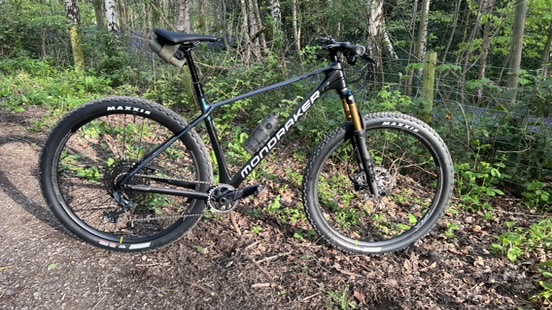
Full-suspension ‘downcountry’ bikes with carbon XC frames and lightweight trail capable kit are a definite thing and probably my favorite mountain bike genre. There are very few hardtail equivalents though, so I’ve was super keen to try Mondraker’s Chrono Carbon DC when it was announced in the autumn. Unfortunately, a seemingly confused component choice, surprisingly backward geometry and an unnecessary frame compromise means it struggles to deliver fully on its clear fast and fun potential.
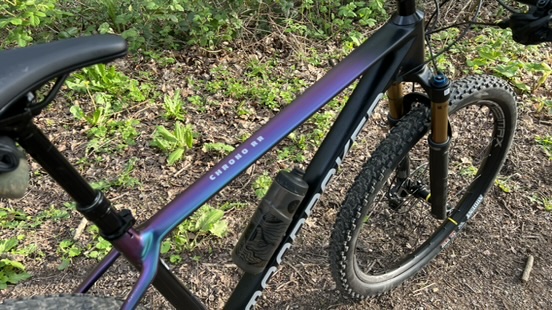
Design and geometry
While the Chrono XC frame has been in the Mondraker line up for a while, they haven’t just stuck a longer fork in to create the ‘DC’ and called it done. This is a whole new frame without Mondraker’s previous signature hump in the flat bladed top tube, plus a UDH hanger and flat mount brake fixtures at the far end. There’s a neat ribbed protector on the skinny chainstays, and the flat blade seatstays fire straight into the dropouts rather than via a tall tower section. Mondraker has also added rectangular troughs in the seat tube and downtube that a plastic block carrying the conventional bottle mounts bolts into. The idea is that removing these blocks lets you counter-sink a magnetic Fidlock bottle mount into the troughs, so that it’s flush with the surface. Having to create a trough in the tubes without reducing strength adds material weight (and presumably manufacturing time) to the otherwise minimalist 1,150g (claimed weight) chassis. The recessed trough also stops seatpost insertion less than halfway down the seat tube. As a result, even with the adjustable OnOff dropper restricted to 140mm from 170mm, the saddle was still 15mm too high for my 745mm bottom bracket to saddle top sweet spot. Presumably, to try and get at least some frame extension to fit the post into, the seat tube is also 470mm tall, making it 10mm longer than the reach. That means potential seatpost issues are compounded by the fact that you couldn’t size down a frame and still get an acceptable length.
I’d be troubled enough about this with most bikes, but ironically Mondraker is the brand that first took long reach, short stem geometry mainstream with their Forward Geometry ‘XR’ bikes. Progressive handling has always been one of their strongest characteristics ever since too. However, while the ‘XC Forward Geometry’ of the Chrono DC is 13mm longer than the Chrono XC bikes, a 460mm reach and drooped 60mm stem on a size large seems more like ‘Backward Geometry’ by the latest XC standards.
As a comparison, the Mondraker Raze Carbon trail bike has a 495mm reach and 445mm seat tube in large, or a 475mm reach and 415mm seat tube in medium. The 74-degree seat tube is also two degrees slacker than the Raze. The new Mondraker F-Podium XC race full suspension bike has a 76-degree seat angle and 480mm reach in a large too.
The 67.5-degree head angle is definitely on the XC side of DC too, with the F-Podium coming in at 66.5 degrees and that will obviously sag symmetrically rather than just sinking at the front like the Chrono. On a positive note, it gives the steering a lively but not nervous steering feel that suits the frame. Relatively short 430mm chainstays do their best to balance out overall proportions of the short end too. Although, as you’ll see later, the component spec still skews things rearward in terms of dynamic feel. The 60mm BB drop grounds the frame in fast or loose turns too, at the expense of grounding pedals more often in stepped or rutted situations.
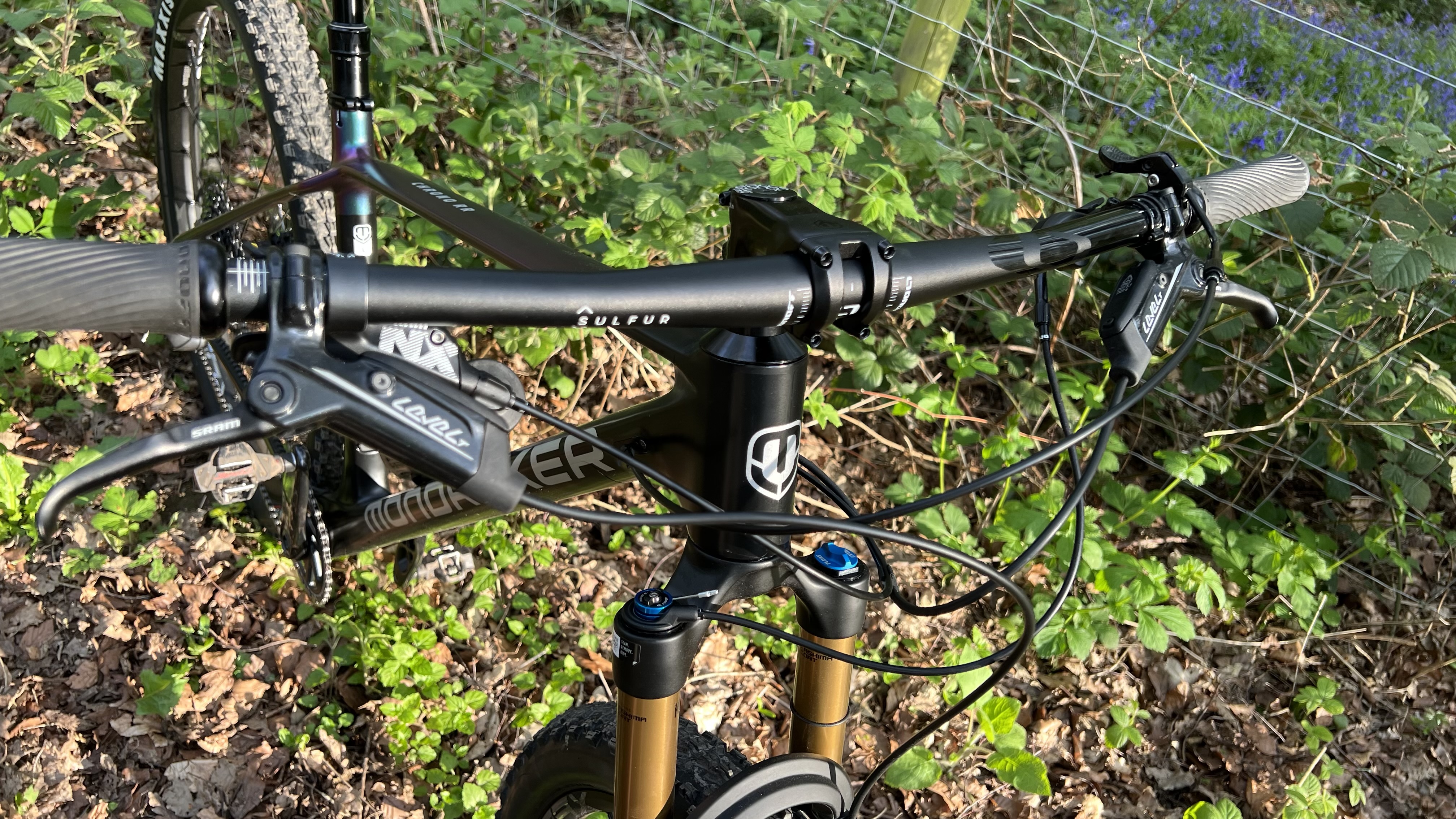
Components and build
Doing downcountry components right is always a compromise between speed and steeze, but a top spec Fox 34 Factory Step Cast fork is always a good start. While the FIT4 damper can feel too firm on a full-suspension bike, the extra low-speed compression resistance matches a hardtail well. It’s the remote control version with a double trigger under bar pod though, which forces the use of a large spoon-shaped remote above the bar. Rather than the riser you might expect for a more controlled, easy front wheel lift vibe on a downcountry bike, the bar is a flat alloy one, with solid feeling lock-on grips. More bar space is taken up by the separate two bolt clamps of the basic spec SRAM Level brakes and band mount NX shifters. The pick-and-mix transmission picks up in class with a 34-tooth GX chainset and cable-operated rear mech, but they’re connected with SRAM’s cheapest 12-speed SX chain. The rear cassette is the very heavy NX group PG-1230 which uses an HG freehub. This limits gear range to 11 to 50 and also complicates upgrading to higher spec SRAM cassettes which use XD freehubs. The actual wheels are Mavic’s smooth and sturdy 1800g CrossMax XL S alloy wheels with a 30mm internal rim width fattening the Maxxis Ardent ‘2.4in’ tires up to 57mm (2.25in).
It comes with inner tubes as standard but valves (and spare spokes and tire levers) are supplied with the bike. If you buy a Chrono DC, get your Mondraker dealer to convert them to tubeless before you pick it up, as the plastic adaptors for the offset rim shape means the valves require more of effort to stop them leaking than most.
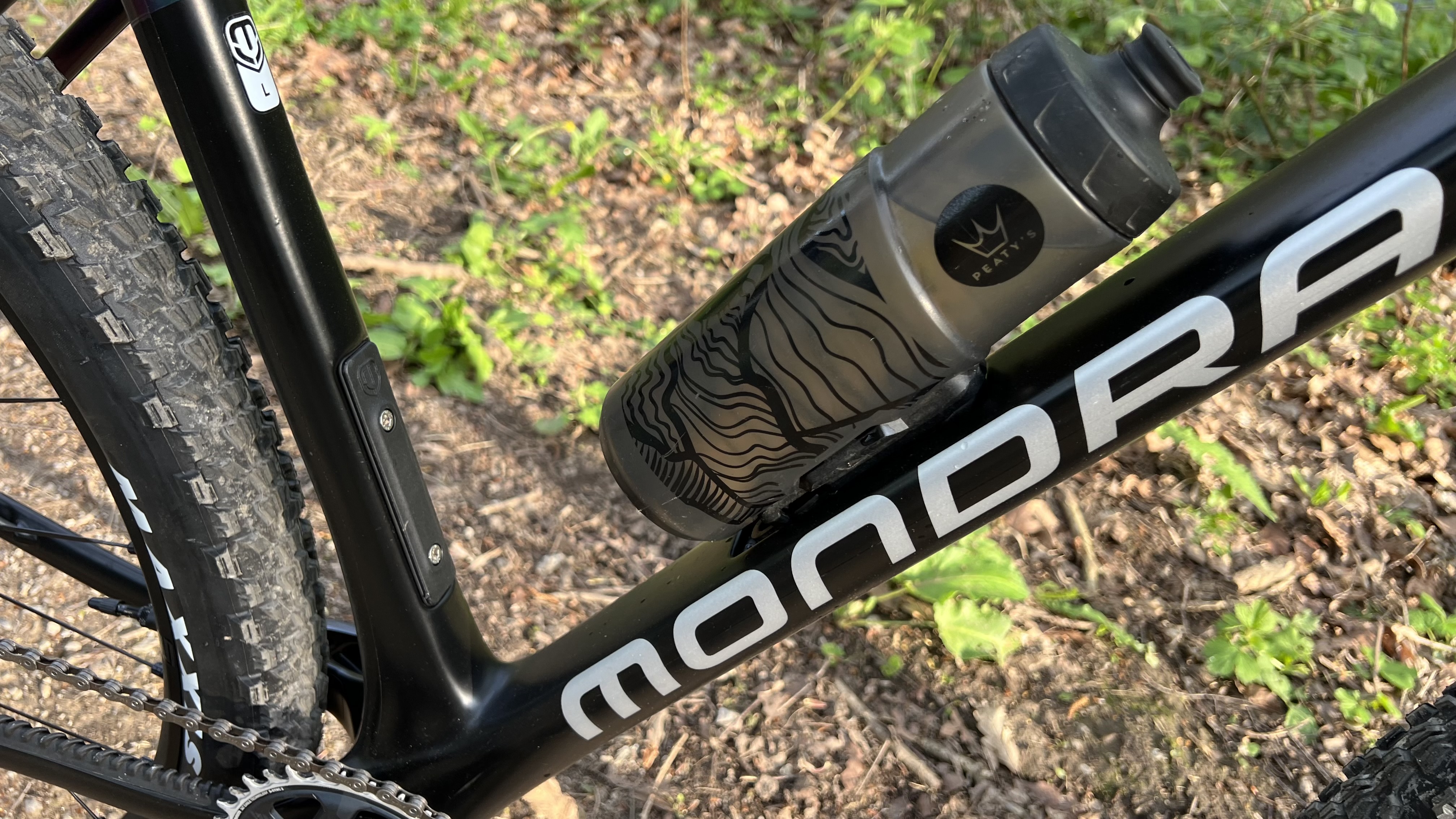
Ride, handling and performance
Let’s start with the positives first as there definitely are some. In terms of mimicking a lightweight full-suspension bike, but without the weight and complexity of a shock and all the pivots and linkages, the ride quality of the frame is excellent. Those bladed rear stays, skinny chainstays make for a very compliant and comfortable connection to the ground. The malleable movement of the rear wheel means consistently excellent traction too – better than many short travel FS bikes with stiff compression damper settings. The short head tube and flat blade top tube mean shocks coming from the front end are sucked up smoothly as well. That means while I’ve complained about Fox’s FIT4 damper being spikey and uncomfortable across trail chatter, I had no such issues on the Mondraker. Even when I forgot to release the lockout (or more to the point forgot that its default setting is locked rather than open), it didn’t break my wrists before the emergency breakaway valve opened up. The Mavic wheels are also smoothly comfortable and from my own previous experience very tough too.
That fluid rear end, soft wheels and very heavy NX cassette definitely suck a lot of power response out of the Chrono DC, so while traction is good, torque definitely feels muted. That doesn’t just cut into climbing performance either, as I’d often be digging deep into the hurt locker on flat but rough track charges in the hope of blowing riders off my wheel only to find them sitting there happily. On such a light frame, that cassette is also enough to unbalance the ride feel, particularly when hopping and popping the bike around. The front end can also get twisty and twitchy without much provocation when letting it run fast in rutted or rooty situations. That stops you really benefitting from the extra stiffness of the Fox 34 forks compared to the lighter 32mm Fox or 30mm RockShox upper leg forks used on the two cheaper Chrono Carbon DC models.
While the low BB keeps it stable through turns, the head angle isn’t relaxed enough to help get things back under control either. The 760mm bar and 60mm stem are also at best ambivalent rather than advantageous in their attitude to technical control. The fact it’s a flat bar makes it harder to lift the front end and seems a signaling miss in marking out – or not – the DC as a more capable bike than the Chrono XC versions. But then if you did fit a riser and shorter stem you’d be looking at an even shorter reach, so you’re snookered there as well. Both bars and grips are relatively uncomfortable despite the forgiving frame too and if you've got big calves they'll rub on the broad seatstay shelf if you push back on descents.
While the gears work OK, the very basic brake feel isn’t what I’d expect on a £3,500 / €3,499 bike. Separate mounting bands and two-bolt clamps staring up at you when you look down aren’t aspirational either, which is a shame considering the paintwork is so stunning. While I personally think a lockout is unnecessary – especially when there are more race-oriented Chrono models available, it does come at a significant cost in terms of dropper lever ergonomics and cluttered cable aesthetics though.
The good news here is that if you’re as triggered by some of the component choices as much as I was, you can upgrade your way out of them. The bad news is that there’s one bit you can’t upgrade around and that’s the ‘Backward Geometry’ and short post insert issues I talked about at the start.
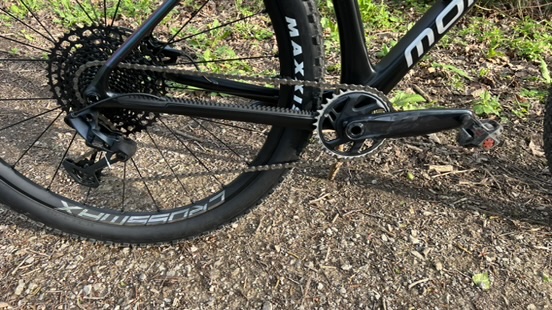
Verdict
If Mondraker had just stuck a longer fork on their XC frame, chucked on whatever mix of post-Covid componentry that was hanging around in stock and called it the ‘DC’ then it wouldn’t have been great, but it would have been vaguely forgivable given the current turbulent times. What’s baffling is that the brand has gone to the trouble of committing to new molds for a gorgeous looking, carbon fiber, state-of-the-art, UDH gear hanger frame, but then hamstrung it with really dated geometry. I’m not even talking from a ‘downcountry/trail’ point of view either, but from a cutting-edge XC perspective. Mondraker have then added a literally ‘niche’ frame feature that makes dropper post fit a massive issue and potentially pushes you onto an even smaller, shorter reach frame just to get the right saddle height.
Test conditions
- Surface: Everything from road to loam, roots and loose rock
- Trails: Road gravel, natural XC, official XC courses, moorland singletrack, red and blue grade trails centre and off piste play trails
- Weather: We actually had some dry, fast and dusty trails for this one, so it’s not the weather that made me exasperated when riding the Chrono DC RR
Tech specs: Mondraker Chrono Carbon DC RR
- Discipline: XC/trail
- Price: £3,599 / €3,499
- Head angle: 67.5 degrees
- Frame material: Chrono 29 Stealth full Carbon
- Fork: Fox 34 Step Cast Float FIT4 EVOL Factory Kashima, 120mm travel
- Sizes: S, M, M/L, L, XL
- Weight: 11.9kg (large as tested)
- Wheel size: 29in
- Chainset: SRAM GX 34T 175mm arms with DUB bottom bracket.
- Rear mech: SRAM GX Eagle
- Shifter: SRAM NX Eagle
- Cassette: SRAM NX Eagle PG1230 12-speed 10-52T
- Brakes: SRAM Level T 2-piston hydraulic disc brakes with 180/160mm rotors
- Tires: Maxxis Ardent 29x2.40, Dual compound, EXO 29x2.4in
- Wheels: Mavic CrossMax XL S
- Bars: OnOff Sulfur 0.2, double-butted 6061 flat alloy 760mm width
- Stem: MDK Alloy, 60 x 31.8mm
- Grips: OnOff Desert, lock-on
- Seatpost: OnOff Pija 140-170mm dropper
- Saddle: Mondraker MDK Series, SRX, steel rail







